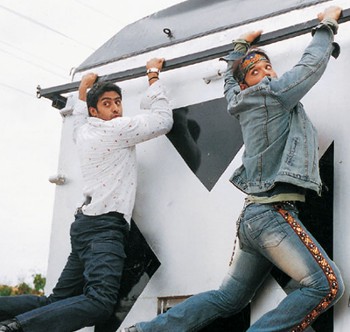
 |
 The quotation reads like any another empty press-byte from a director trying to sell his film; it doesnât say much about either the film or its making, just that some changes were made during conceptual stages. After watching âDhoom,â however, one realizes the enormous extent to which Mr. Gadhviâs words have dictated his work; the ingredients the director mentions are the heart and soul of his exhilarating new film. If âDhoomâ is the cinematic equivalent of an unstoppable motorcycle ripping through miles of road in a matter of seconds, the filmâs cast and formal momentum are the fuel that keeps its engine racing full-speed ahead. The filmâs foremost asset is its successful amalgamation of aesthetic conventions from Hindi cinemaâs own unique action-cinema pedigree with the bells-and-whistles of big-budget Hollywood productions; as a result of which, it stands as a distinct effort that is essentially unlike other action films being produced in the Hindi film industry today. What other film in recent memory evokes both the nostalgia we associate with Bollywood cop dramas of the 70âs and 80âs, and the feel of Hollywood guilty pleasures such as âThe Fast and the Furiousâ and âTorque?â
The protagonist cop aims to take down the robbers, but why does the audience care if he succeeds or fails? In this film, itâs certainly not because of the inherent immorality of the crime in question. Audiences are never given a clue as to the repercussions of the robberies committed or even who exactly the crimes end up hurting. If anything, the exciting, sleek heists presented in the film glorify criminal behavior. Audience investment is drawn from the characters. Viewers identify with the ambitious police officer and the flippant motorcycle prodigy as much as they admire the debonair leader of the gang of thieves (John Abraham). Consider the reason why comic-book fans often ask the question, âwho would win in a fight, Superman or Batman?â When charismatic and alluring individuals are forced into an adversarial situation, the outcome is bound to be nothing short of spectacular. Excitement and curiosity are bound to peak. The film capitalizes on this maxim to excellent effect. The narrative, in its purest form, consists of a series of increasingly heated encounters between the brave policeman and the dashing criminal; and each encounter masterfully sets up the next. As the film races towards its conclusion, the charactersâ goals and the consequences of not meeting them are built up more and more; finally, the stakes are as high as they can get, and audiences canât wait for the rivals to tear into each other one last time, to settle things once and for all.
Gadhvi relies on the formal elements of the film to further a sense of intensity and excitement - the ârushâ that he spoke of to his producer. Innovative cinematography has been combined with seamless special effects, adroit stunt coordination, remarkably well-staged action, and terrific editing to create some of the most spectacularly kinetic thrills ever witnessed on Bollywood screens. Even the filmâs music and choreography are charged with a brand of zest and energy unparalleled; each song in âDhoomâ is the kind that would be considered the âpeppy numberâ in other soundtracks. Not surprisingly, there isnât a single mildly-paced melody in the entire bunch.
âDhoomâ is an exceptionally enjoyable action film, and the filmmakersâ creative charge, sincerity, and ingenuity are apparent throughout its duration. In the same interview I mentioned earlier, Gadhvi expressed his optimism that his new film would be appreciated. "I believe that if you do your work sincerely and with integrity, it will never go wrong,â he remarked. Finally, he added, âPeople will love âDhoom.ââ What an interview, I must say. Once again, what seemed like shallow self-promotion turned out to be honest acumen.
|
| Comments | Contact Us | Advertise | Terms of Service | Privacy Policy |